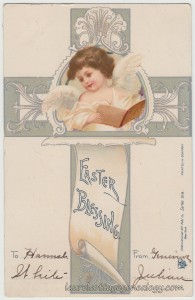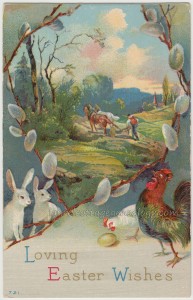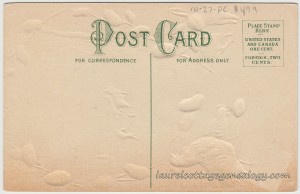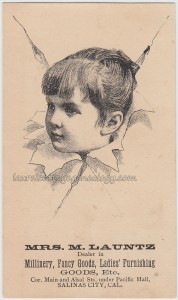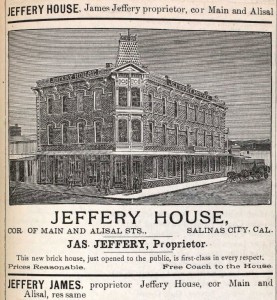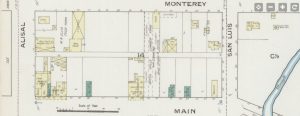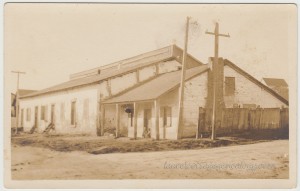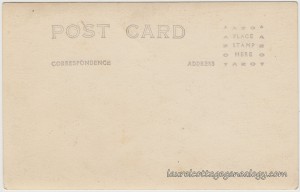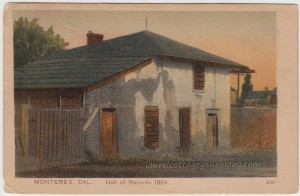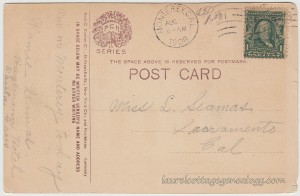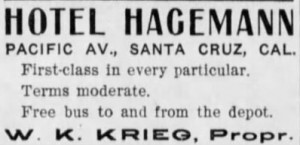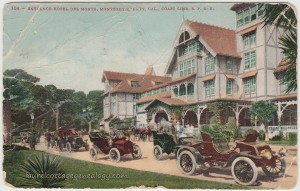
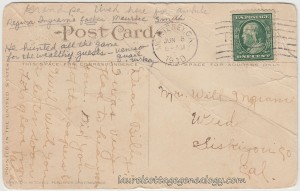
“704 – Entrance Hotel Del Monte, Monterey County, Cal., Coast Line, S. P. R. R.”
There’s so much going on with this postcard…
Early autos
Well, for starters, this continues the topic from the prior post – early American cars – steering wheel on the right. You can see that the first two vehicles from the right – have their steering wheels on the right, while the third one in line, has it’s wheel on the left. The card was postmarked in 1910, and it may have been produced from a newspaper photograph of that year or within several years prior. However, if you’ll notice – the “driver” in the third car is a woman, while the man next to her looks more “geared up” in coat and hat, to drive. Maybe they switched places for the photo, or maybe the image was altered for the postcard, and the wheel was drawn in on the left. (We’ve seen similar alterations on other old postcards.)
The car on our right is possibly an early Winton, with that continuous curved fender. I found a four-seat 1904 model displayed at Early American Automobiles, the 9th photo down on the left; you can check out the similarities between the two. Wikipedia’s entry regarding the “Winton Motor Carriage Company” shows the famous two-seat touring Winton “Vermont” (again with that distinctive fender.) It was 1903 that Dr. Horatio Nelson Jackson, along with his mechanic, made the first successful automobile trip across the U.S. in a “Vermont.”
The Hotel
The luxurious Hotel Del Monte, was built by railroader Charles Crocker, and operated from 1880 – 1942. It was part of a 20,000 acre resort; a playground for the rich and famous, and a big part of the Central Coast’s history. See “St. John’s Chapel, Del Monte, California” for a related post. The hotel showing on this postcard would have been the second of three; the first two being destroyed by fire. The wooden, Gothic first and second hotels were designed by Southern Pacific Railroad architect, Arthur Brown, Sr. and built by S.P.R.R. workers.
The Coast Line
Opening January 1, 1880, the Monterey Branch of the Coast Line of the S.P.P.C. ran from Castroville to Pacific Grove; linking San Francisco to the Hotel Del Monte and Pebble Beach. It included Southern Pacific’s longest running “named” passenger train, the Del Monte, which ran from San Francisco to Pacific Grove, and mainly served wealthy tourists. This passenger train made her last run on April 30, 1971.
The sender wrote:
“Dear Billy, I was very glad to hear from you. Did you get the papers? I will write you a letter soon. Lots of Love from Ada.”
The card is addressed to: “Mr. Will Ingram, Weed, Siskiyou Co. Cal.”
Game hunting for the wealthy
The great thing about this postcard is the added info at the top, which must have been written in later years and by a relative: “Grandpa lived here for awhile. Regina Ingram’s father Maurice Smith. He hunted all the game for the wealthy guests – venison, quail, turkey.”
Regina Ingram was Lilac Regina Smith (Lilac – love that!) born in 1895 in Monterey. She married William Ingram, the recipient of the postcard, born 1885 in Monterey. From research on Ancestry.com, the postcard sender, Ada, was likely William’s sister. Regina’s father, Maurice Smith, was born in New York about March 1865. He appears as early as 1880 (from the census) living in Monterey, and on subsequent census records with his wife and children. No clues were found in records as to when exactly he would have stayed at the Del Monte, perhaps early on before his marriage, which was in about 1892. The town of Weed in Siskiyou County is located almost 400 miles north of Monterey, up Highway 5. The 1910 Federal Census taken in nearby Edgewood, shows William living with some family members: Amy Ingram, William’s sister, was running a hotel; another sister, Mary, was working there as a waitress; and he and brother George, were working for the Weed Lumber Company as bricklayers.
Divided back, used postcard. Postmarked June 8, 1910 from Monterey, California. Publisher: Edward H. Mitchell, San Francisco.
Price: $18.00
Sources: “1904 Winton. Winton Motor Carriage Co., Cleveland OH. 1897 – 1924.” Early American Automobiles. Web accessed April 1, 2015.
Winton Motor Carriage Company. n.d. http://en.wikipedia.org/wiki/Winton_Motor_Carriage_Company. (accessed April 1, 2015).
California’s Most Historic Resort: Hotel Del Monte. Naval Postgraduate School. Web accessed April 3, 2015. [http://nps.edu/About/Publications/HotelDelMonte_updated_Final.pdf]
Castroville to Pacific Grove: The Monterey Branch. Abandoned Rails. Web accessed April 3, 2015. [http://www.abandonedrails.com/Monterey_Branch]
Year: 1880; Census Place: Monterey, Monterey, California; Roll: 69; Family History Film: 1254069; Page: 252A; Enumeration District: 057; Image: 0505. (Ancestry.com)
Year: 1910; Census Place: Monterey, Monterey, California; Roll: T624_89; Page: 20B; Enumeration District: 0013; FHL microfilm: 1374102. (Ancestry.com)

